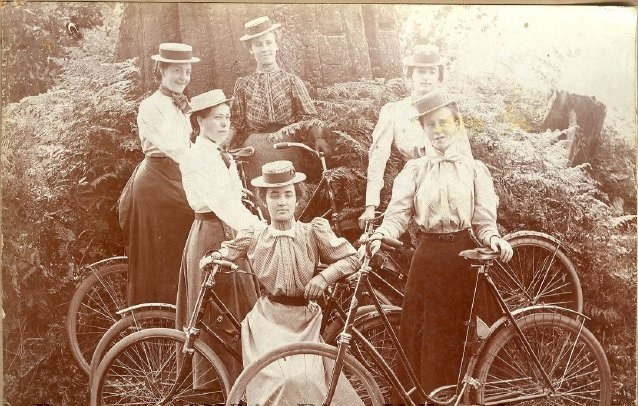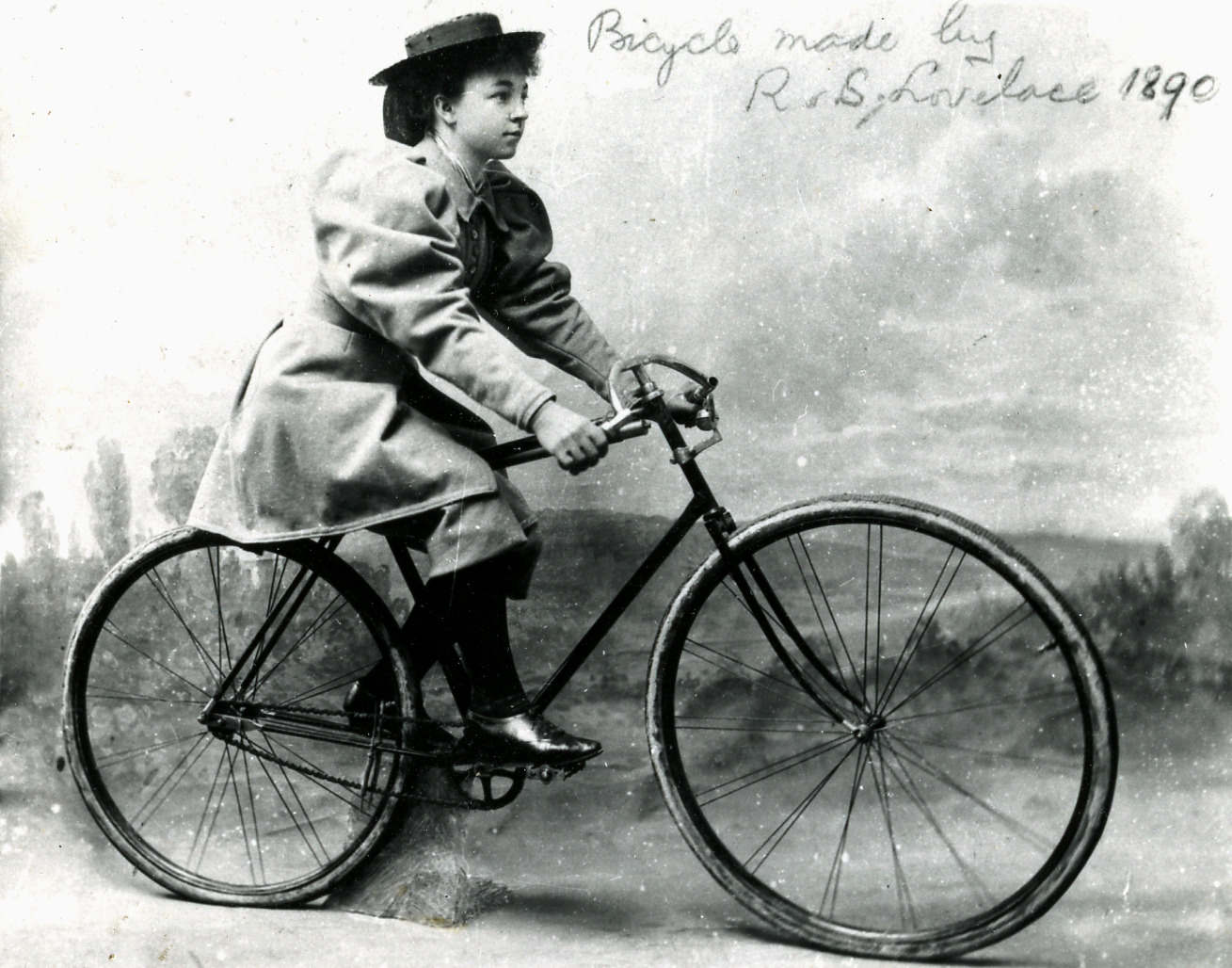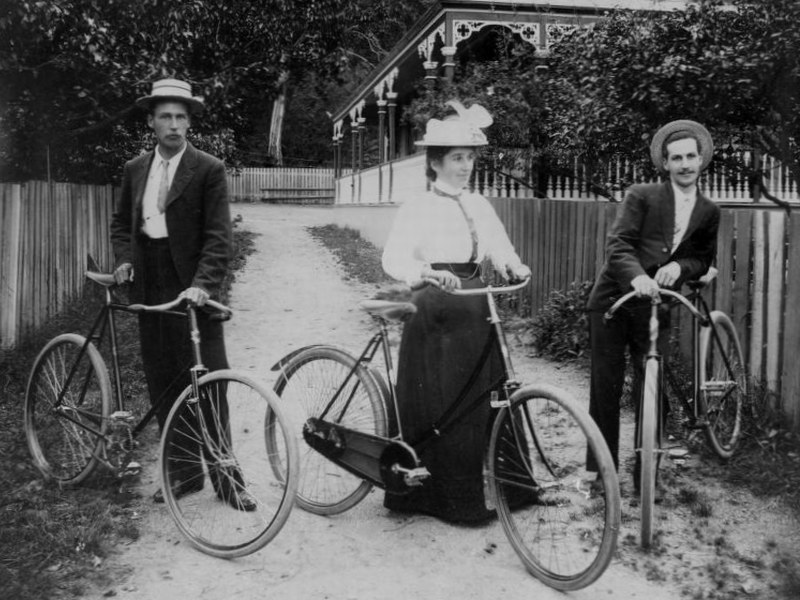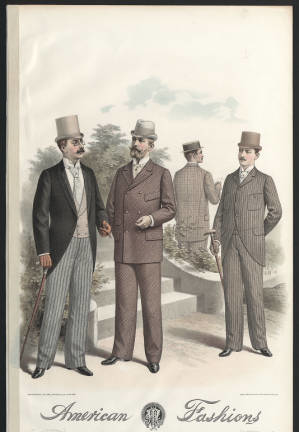A Bicycle Built for Fashion

by Sahrye Cohen, First published for the March/April 2010 issue of Finery
The late Victorian era saw an increase in the middle class and the rise of a lifestyle in which, for the first time, many people had a certain amount of leisure time. A number of recreational activities became popular among the upper and middle classes including bathing, lawn-tennis, croquet, and bicycling. While many women and some men undertook these activities in conventional dress, others dressed in costumes and fabrics specifically recommended for athletic activity. Basic day clothes were adapted and customized for increasingly popular athletic pursuits.
Illustrations from an 1895 issue of La Mode Illustree, show women in bathing clothes, lawn-tennis costume, boating costume, a bicycling outfit with bloomers, and a hiking costume with skirt lifters so that the hem can be raised for walking ease. Descriptions of these clothes from women’s magazines of the era indicate that these outfits were made in a wide variety of sturdy cotton, linen and woolen fabrics including serge, tweed, flannel, and duck. Photographs from the 1880s to 1910s show average American and British women wearing specific hunting, cycling and hiking outfits similar to those in fashion plates.
The invention of the safety bicycle in 1885, and the pneumatic tire in 1888, brought about a revolution in cycling. In 1894 a new cyclery was built in San Francisco’s Golden Gate Park that included several pubs, indoor parking for 200 bicycles, and lockers, showers and baths for both men and women. Bicycling provided women with an opportunity for exercise and a newfound mobility and independence.

While many women still preferred to bicycle in skirts, the bloomer or knickerbocker costume became an acceptable alternative. Dress reformers, such as Amelia Bloomer, had attempted to popularize rational dress and bifurcated garments since the 1850s with little success. However, as the social stigma decreased and the numbers of women riding bicycles increased, the bifurcated bicycle outfit became a chic fashion item in the 1890s. The Ladies’ Standard Magazine, April 1894, recommended a full woolen cycling outfit consisting of heavy undergarments, bloomers, leggings to the knees, a corset waist and in cooler weather a sweater or double-breasted box coat. Other magazines recommended light-weight wool, cotton or linen for warmer weather. The corset was retained in many cycling outfits as a necessary component of fashionable dress and contemporary advertisements display corsets specifically for sporting and bicycling that extol the virtues of additional elasticized panels and sanitary woolen fabric. While magazine articles recommended practical darker colored fabrics, like browns and blues, for cycling costumes, advertisements from the period show women in reds, pinks, and brightly striped outfits.
Dress for fashionable men consisted of a shirt with starched collar, braces, vest, a tie and tie-pin, and morning coat, or other suit coat, trousers, and a profusion of hats including bowlers, soft hats and top hats. Like women, men had special clothes designed for sporting activities including linen clothes for tennis and summer wear, and knickerbockers for sporting activities including linen clothes for tennis and summer wear, and knickerbockers for bicycling. Men’s Clothing and Fabrics in the 1890’s illustrates sporting outfits in serge, duck, and flannel, and wool manufacture’s samples for bicycle suits in several variations of gray, brown and tan wool.
Victorian sporting wear can also be an exciting addition to your steampunk or fantasy wardrobe as the simple tailored shapes of this era are an excellent base for accessorizing. Bloomers, vests, leggings, and driving goggles would surely be in the closet of any aeronaut or adventurer.

Transcription: Gertrude. “My dear Jessie, what on earth is that Bicycle Suit for?” Jessie. “Why, to wear, of course.” Gertrude. “But you haven’t got a Bicycle!” Jessie. “No: but I’ve got a Sewing Machine!”
There are many resources available to the costumer attempting a sporting costume. Ageless Patterns, Laughing Moon, Truly Victorian and Simplicity all carry patterns for sporting outfits, corsets, riding clothes and motoring dusters, as well as everyday wear for men and women. The Kyoto Costume Institute and Los Angeles County Museum of Art have examples of extant costumes.





Leave a comment